Every day I receive health screening forms from women who come onto the MyMT™ lifestyle change programmes. Over 50% of them tick the box that tells me they have sore joints and muscles.
It’s the same when women come to my live-events. When I ask who has sore joints and muscles, many hands shoot straight up. Nearly all of them have never identified their sore joints, aching muscles and restless legs as a symptom of menopause. As I didn’t either. 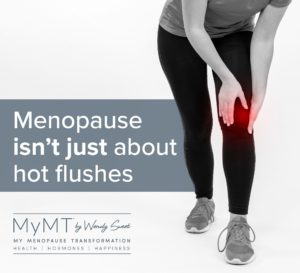
It’s not just our ovaries that have oestrogen receptors. Our heart, blood vessels, liver, brain, thyroid, gut, small intestine, muscles, tendons and fat cells all have these tiny oestrogen receptors too. When oestrogen production declines as we move into and through menopause, these other structures are affected too.
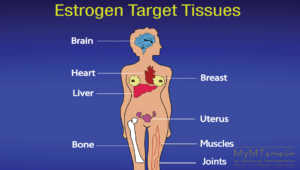
It’s why as part of all the MyMT™ programmes [Circuit Breaker, Transform Me and Rebuild My Fitness], I have a complete module on turning around joint health during menopause.
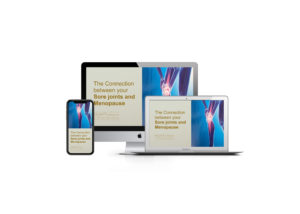
As the first generation of women to come through the modern fitness and sporting industries and enter our menopause transition, it’s important to sort out our aching knees and sore joints so we can keep doing the activity that we love to do.

That’s why, in this post, I’m going to talk about the effect of your hormonal changes on your joint and muscle health as you transition through menopause.
When I designed the MyMT™ programmes, not only did I have a ‘physiology-hat’ on, but also my ‘socio-cultural hat’ too. It took me many years to do my PhD and what I loved the most was exploring the connections that have been made between how we live our lives as we age and how much our beliefs are influenced by the political, social, cultural and historical landscapes that we have engaged in over our lifetime.
Because of the readings I did in this area, I came to the realisation that women in their 50’s today are unique in terms of many of the symptoms we are experiencing in menopause compared to our mother’s generation. We are the first generation of women to come into menopause in the context of the modern fitness and sporting industries and for many, the changing landscape in terms of the fitness and sports that many have engaged in for years.
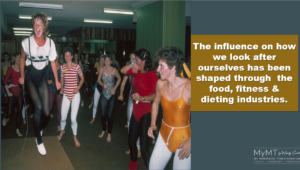
Think about it. Our mother’s generation or grandmother’s generation, never did the amount and type of exercise that we have enjoyed. Nor did they have the incredible influence of sports and exercise science, including sports nutrition, supplements, weight loss diets and popular exercise regimes, changing our beliefs (or more-often confusing us) about how to exercise, eat and compete. But as we move into and through menopause, it’s time to think about how to change what we are doing to better match our changing hormonal health at this time of life. When I began to experience symptoms such as sore joints and muscles as well as insomnia, and for me, my weight was going up despite exercising regularly, I turned to my doctoral research on women’s ageing. Our transition into menopause is the start of our biological ageing, so when we know how to adjust our daily lifestyle to accommodate our changing hormonal environment, we can reduce the impact of our symptoms.
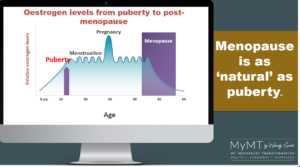
That’s why I often talk about our muscle and joint health at my seminars. And I’m so glad that I do, because many women are continuing to do the same exercise they did when they had oestrogen, as I used to as well! I was so pleased when, after one of my seminars, a physio came up to me and said,
“Thank you so much for challenging me about the role of changing oestrogen on our joint health. I see this all the time in my practice – women who are doing so much high-impact exercise and not sleeping and then experiencing sore joints and muscles that we often can’t explain.”
That’s when I pointed her to the literature on the effect of oestrogen on tendon and ligament metabolism and function.* Oestrogen plays a huge role in our joint and muscle function. Prior to menopause, oestrogen helped our joints to stay supple. Not only did higher levels of oestrogen help our collagen production but oestrogen is also involved in the ability for our muscles to tolerate heavy loads and to heal and recover overnight. Collagen is an important part of this process of cell regeneration as we age, so another thing you can do is increase your collagen-building foods in menopause too. Bone-broth soups are great and feature in the MyMT Food Guide which is an essential part of the MyMT™ programmes.
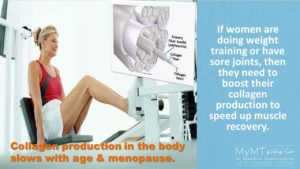
This is what I teach women to do in the MyMT 12 week programmes.
Exercise recovery and sore joint management is all to do with understanding the role that oestrogen plays in the uptake of Vitamin D and the production of calcium (calcium helps muscles to contract).
Oestrogen plays a significant role in helping tocopherol (Vitamin E) get across the joint membranes to help keep them healthy.* It makes sense then, that when oestrogen levels decline in menopause, our joint and muscle function is affected too.
Because our joints and tendons have oestrogen receptors then there are four things that are important to do to manage your joint health in menopause:
- Change your exercise to suit our changing joint, tendon and muscle health. This is especially if you have done a lot of high impact-type exercise over the decades as many of us have, because you may already be carrying inflammation in your joints.
- Change your nutrition so that you focus on an anti-inflammatory diet (this is the type of diet I have in the MyMT programmes, with less emphasis on high amounts of protein, heavily promoted in the fitness and sports industries, which can increase joint inflammation as we get older).
- Sleep all night. Without sleep, your body is not healing and repairing. This is the fundamental priority for you to restore during menopause and it’s the foundation module in the Circuit Breaker programme and the Transform Me programme for women needing to learn how to lose their menopause and post-menopause weight.
- Increase your intake of Olive Oil, which is rich in Vitamin E (Tocopherol).
All throughout the 1980’s and 1990’s I ran almost daily, did triathlons, including Ironman. I also helped to pioneer the BodyPump classes and taught high-impact aerobics for years. Sporty Spice indeed. So, when I began to look at Theories on Aging as part of my studies and discovered that there was a ‘wear and tear’ theory of ageing, I realised that I needed to look through this lens as well. The wear and tear theory of ageing was first introduced in 1882, by Dr. August Weismann, a German biologist. He believed that cells and tissues have vital parts that wear out resulting in more rapid ageing.
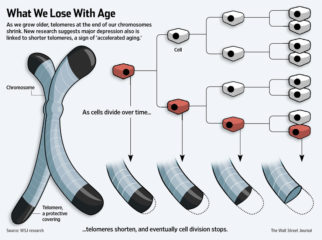 Like components of an ageing car, parts of the body eventually wear out from repeated use, killing them so as they aren’t able to replace. Scientists now know that there is some basis for this theory, especially because when we lose the ‘hard-caps’ on our DNA, known as the telomeres, this can increase the rate of inflammation and cause more rapid ageing of our joints and tissues.
Like components of an ageing car, parts of the body eventually wear out from repeated use, killing them so as they aren’t able to replace. Scientists now know that there is some basis for this theory, especially because when we lose the ‘hard-caps’ on our DNA, known as the telomeres, this can increase the rate of inflammation and cause more rapid ageing of our joints and tissues.
This is also why it’s important for some of you to switch up the exercise you are doing and , so you don’t make your joints any worse! Whilst both the Circuit-Beaker and Transform Me programmes don’t have a lot of emphasis on exercise, my new Re-Build My Fitness programme helps women choose the right exercise to help them transition through menopause.
I’ve taken 4 tips from these programmes to share with you too:
- Change to non-impact or low-impact activity.
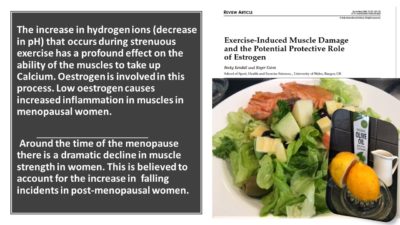 Whilst this seems obvious, many of our generation are so used to high-impact exercise, that we push ourselves through the pain. In your menopause transition, can I advise you not to!
Whilst this seems obvious, many of our generation are so used to high-impact exercise, that we push ourselves through the pain. In your menopause transition, can I advise you not to! - Ensure you have Omega-3 rich olive oil to help your joint health. This is high in tocopherol which your lovely joints need.
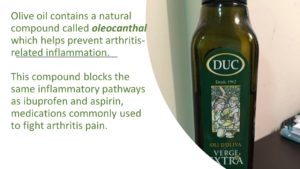
- If you aren’t sleeping or you are over-weight, then it’s really important for your joint and muscle health as you age, to sleep all night and lose weight. If you are interested in losing your weight then please look at my Transform Me’ programme . If we aren’t sleeping, then we aren’t healing overnight. When we aren’t getting our restorative sleep, our immune health suffers. Some women then head towards an inflammatory condition called fibro-myalgia. It is very common in menopause and requires a medical diagnosis.
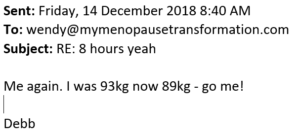
- Your bones, muscles and joints need to strengthen and lengthen as you transition menopause. The right strength training and stretch programme can actually stimulate the cells in your muscles and tendons to renew and repair. Maintaining physical strength is a key strategy that leads to healthy ageing and in the Re-Build My Fitness programme, I have body-type specific programmes for you.

Maintaining skeletal muscle mass and strength is vital for your healthy ageing, but this can only be achieved when you reduce the inflammation that is already in your bones and joints and get sleeping all night. I am really concerned with the number of women who arrive in mid-life and experience sore joints and muscles that are keeping them from being active, which we all know is so important to our health as we age.
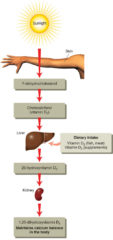
Watching your Vitamin D levels is important, so get this checked if you can. Vitamin D helps to make calcium in your body, which is important for nerve transmission into our muscles. When Vitamin D is low (which is important for many of you going into winter months at the moment), then your hot flushes can become worse too. It’s why I’m so passionate about you understanding how best to manage your symptoms with the right lifestyle strategies in your menopause transition. This includes your nutrition, exercise and sleep management.
Some of you might have lost the will to exercise because you are tired, sore, not sleeping and you have no motivation or time, but getting back into exercise is crucial to ensuring that your joints, muscles and tendons remain healthy, supple and strong at this stage of your life. Again, I have scientifically-evidenced lifestyle strategies to help you to turn this around.
When you are ready, I hope you can join me on any of the powerful online My Menopause Transformation programmes. I’ve designed these for women who are transitioning into and through menopause, or who might be already in post-menopause. The programmes focus on the 7 pillars of women’s healthy ageing research and women love how much better they feel.
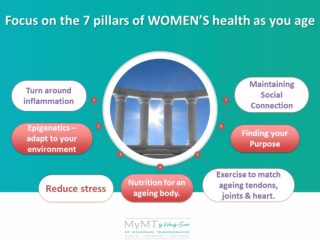
If you would like to get into 2019 and stop feeling tired and depressed and instead feel energetic, healthy and ready to live life again and enjoy your 50’s, then please come and join me. These programmes have now been completed by over 2000 women world wide. Whether you want to reduce your symptoms with Circuit-Breaker, lose weight with Transform Me or get the right exercise into your life with Re-Build My Fitness, I look forward to you joining me on any of my online programmes. As I say to the women on these programmes already, there’s no looking back to what we’ve done in the past. Our menopause transition is a whole new game! It would be my privilege to help you too.
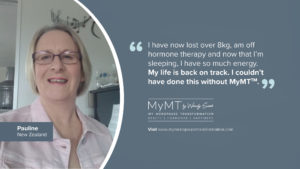
*References:
Frizzerio, A. et al. (2014). Impact of oestrogen deficiency and aging on tendon: Concise review. Muscles, Ligaments and Tendons Journal, 4 (3), 324-328
Kendall, B. & Eston, R. (2002). Exercise-Induced Muscle Damage and the Potential Protective Role of Estrogen. Sports Med. 32(2), 103-123.
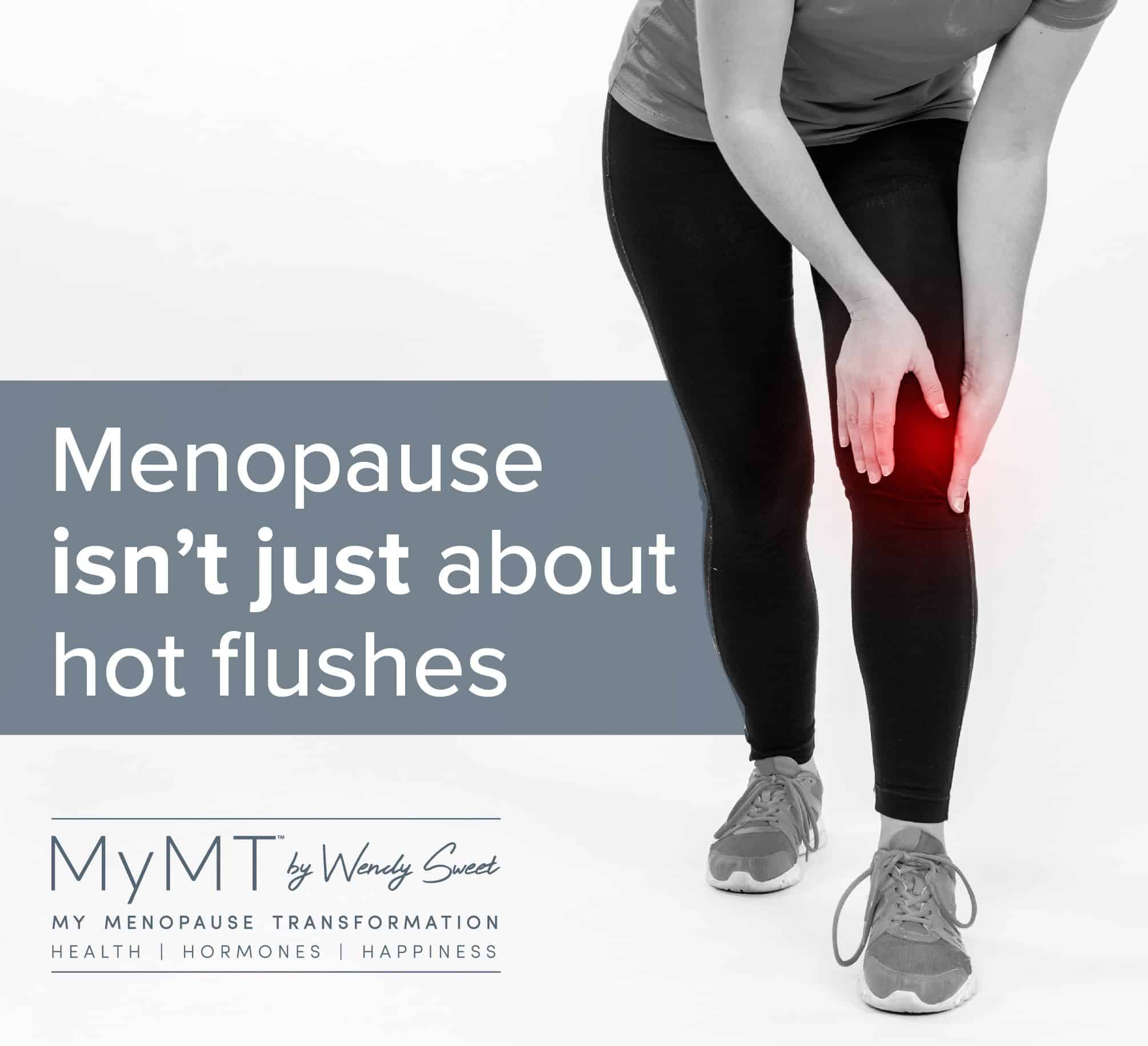
 Wendy
Wendy 